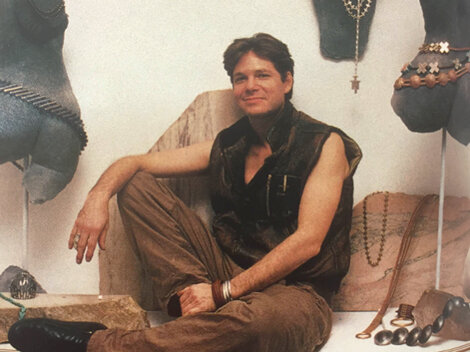164
164
USA, c. 1975
ebony, sterling silver, brass-plated sterling silver, zebrawood 2 w × 7 l in (5 × 18 cm)
ebony, sterling silver, brass-plated sterling silver, zebrawood 2 w × 7 l in (5 × 18 cm)
estimate: $3,500–4,500
follow artist



Robert Lee Morris’ jewelry designs effortlessly meld sensual, natural materials with bold and elegant forms. Influenced by cultures from around the world, Morris creates monumental pieces to complement the human form that appear to be simultaneously primitive and futuristic. His works echo the sublime beauty of nature and his use of organic materials imbues his designs with splendor and mystery.
Morris began his formal training studying art and archaeology at Beloit College. After graduating, Morris founded a commune, which was loosely modeled on William Morris’ Arts and Crafts community. Morris created jewelry, teaching himself how to metalwork using hardware store materials. The commune burnt down in the 1970s, but Morris continued to hone his craft.
His works caught the eye of a respected gallery owner who displayed Morris’ work at the Sculpture to Wear gallery in the lobby of the Plaza Hotel alongside jewelry by Man Ray and Alexander Calder. In 1976 his gladiatorial bubble necklace was featured prominently on the cover of Vogue, launching Morris’ career to new heights. The following year Morris opened his SoHo store Artware, collaborating with top fashion designers including Karl Lagerfeld, Geoffrey Beene, and Kansai Yamamoto and Cher, Oprah and Bianca Jagger were among his acclaimed clients.
Morris' bold designs have been featured prominently in the fashion shows of Donna Karan, Calvin Klein and Michael Kors. Morris was honored in a retrospective exhibition, Metalmania: Robert Lee Morris, at the Fashion Institute of Technology in 1996. In 2007, he was awarded the Geoffrey Beene Lifetime Achievement Award from the Council of Fashion Designers of America (CFDA), securing his place as one of the most innovative and inventive jewelry designers of the late 20th century.


I've always wanted my work to be more available...I wanted to offer a range of crazy, experimental, one-of-a-kind pieces that would have integrity and be made of great construction as well as interesting engineering.
Robert Lee Morris
Jewelry is one of the most graphic indicators of personal identity. In sync with the body, it helps to define the individuals who wear it. Jewelry is also among the most revealing examples of material culture. The necklaces, earrings, bracelets, rings, and brooches worn by people throughout the ages contain powerful clues about the eras, traditions, habitations, and societies in which they lived.
To this day, jewelry continues to act as an important signifier. The twentieth century, along with the first two decades of the twenty-first, is particularly rich in what we refer to as “studio jewelry.” Studio jewelry, which is invariably handmade, can simply celebrate process and provide an alternative to fine or costume jewelry, but it can also harbor deeper meanings—concepts far beyond jewelry’s usual function as decoration, commemoration, or talisman. Studio jewelry exists at the nexus of art, craft, and design, often reflecting aesthetic concerns, theoretical doctrines, political agendas, or popular trends. Most studio jewelry is either unique or produced in limited edition. It can be fabricated from precious metals and gemstones, or created from materials outside the norm, or both. Studio jewelry may be easy to wear, or present tactical challenges. All in all, it is a most compelling adornment—whether we regard it technically, stylistically, artistically, or even existentially.

Auction Results Robert Lee Morris